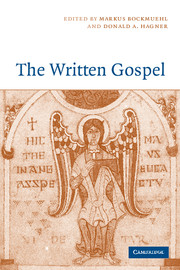Book contents
- Frontmatter
- Contents
- List of contributors
- List of abbreviations
- Introduction
- PART I BEFORE WRITING
- PART II WRITING THE FOUR GOSPELS
- 5 Who writes, why, and for whom?
- 6 How Matthew writes
- 7 How Mark writes
- 8 How Luke writes
- 9 How John writes
- 10 Beginnings and endings
- PART III AFTER WRITING
- Appendix: Graham Stanton's publications
- Bibliography
- Index of ancient sources
- Index of authors
7 - How Mark writes
Published online by Cambridge University Press: 07 December 2009
- Frontmatter
- Contents
- List of contributors
- List of abbreviations
- Introduction
- PART I BEFORE WRITING
- PART II WRITING THE FOUR GOSPELS
- 5 Who writes, why, and for whom?
- 6 How Matthew writes
- 7 How Mark writes
- 8 How Luke writes
- 9 How John writes
- 10 Beginnings and endings
- PART III AFTER WRITING
- Appendix: Graham Stanton's publications
- Bibliography
- Index of ancient sources
- Index of authors
Summary
This chapter is concerned with how the Marcan evangelist wrote, not what he wrote. The distinction is important. I am not directly concerned with genre, though the chapter may well have implications for understanding the genre of Mark. Rather, we are interested in the way that the evangelist puts his materials together, contextualizing them, and why – if it can be discerned – he did what he did. But our approach is limited, for we do not possess Mark's sources (as we do for Matthew and Luke), and so we often cannot distinguish between the evangelist's source and his redaction.
The primary focus of this chapter is on how the evangelist arranges his material, especially that intriguing feature variously described as intercalation or ‘sandwich’. A few other aspects of the evangelist's habits of arrangement will also be taken into account. The chapter is developed in three parts: (1) aspects of Marcan style, (2) the function of digressions and sandwiches, and (3) a proposal regarding Mark's bipartite structure.
ASPECTS OF MARCAN STYLE
Much has been said about Marcan style (Elliott 1993b; Turner 1976:11–30). It is Semitic. It is unpolished. It is stylistically and grammatically flawed. We find examples of parataxis (as seen especially in frequent usage of kai), redundancies (e.g., 1.28, 32, 35; 4.2, 39; 5.15, 19; 6.25; 7.33; 12.44; 14.61), pleonasm, and the historical present (some 150 in all), and on occasion use of the wrong word (e.g., paiein in 14.47, which should be patassein).
- Type
- Chapter
- Information
- The Written Gospel , pp. 135 - 148Publisher: Cambridge University PressPrint publication year: 2005
- 1
- Cited by



